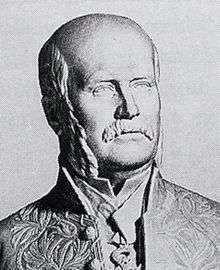Eugène Belgrand
Eugène Belgrand (23 April 1810 – 8 April 1878) was a French engineer who made significant contributions to the modernization of the Parisian sewer system during the 19th century rebuilding of Paris. Much of Belgrand's work remains in use today.[1]
Eugène Belgrand | |
|---|---|
 | |
| Born | 23 April 1810 |
| Died | 8 April 1878 (aged 67) Paris |
| Nationality | French |
| Alma mater | École des Ponts et Chaussées and École Polytechnique |
| Occupation | Civil Engineer |
Civil engineering
Prior to 1850, the water system in Paris was inadequate for its growing population. Waste water was discharged into the Seine, a primary source of the critically limited supply of drinking water.[2] Baron Haussmann, tasked by Napoléon III to modernize the city, appointed Belgrand as Director of Water and Sewers of Paris in March 1855.[3] Hausmann had been impressed by the École Polytechnique graduate's application of geology to water engineering during the design of a fountain in Avallon and he became an engineer from the Ponts et Chaussées School and integrated the Yonne technical services in Avallon in 1849. He studied the ancient languages.
Belgrand embarked on an ambitious project. The tunnels he designed were intended to be clean, easily accessible, and substantially larger than the previous Parisian underground.[4] Eugène Belgrand took part in the renovation of Paris under the leadership of Haussman between 1852 and 1870: he created an innovating network of underground pipes to prevent Paris from being flooded. Under his guidance, Paris's sewer system expanded fourfold between 1852 and 1869.[5] He also addressed the city's fresh water needs, constructing a system of aqueducts that nearly doubled the amount of water available per person per day and quadrupled the number of homes with running water.[6] Belgrand remains famous for his works, consisting the Paris sewers, the aqueduct on the Vanne river between Arcueil and Cachan, the aqueduct on the Dhuis and a dam of Montsouris which stored the water.
Public reaction to the improvements was overwhelmingly favourable, supported by tours of the newly constructed sewer system and a series of photographs taken by Nadar,[7] pioneering the use of artificial lighting for photography.[8] Belgrand shared his insights with others, writing "monumental publications"[9] detailing his work and the science behind it.[10]
Belgrand's projects remain "one of the most extensive urban sewer systems in the world"[1] and served as a "transitional phase" leading to modern wastewater processing.[11] Belgrand wrote the history of Paris.
Commemoration
To commemorate his work in Parisian civil engineering, Belgrand's name is one of 72 names engraved on the Eiffel Tower, opposite the École Militaire.[12] The main gallery of the Paris Sewer Museum[13] is also named in his honor, as is a street in Paris.[14]
Now his name is a school's name in the small town of Ervy-le-Châtel.
References
- Riding, Alan (1992-07-12). "The Sights Beneath the Sidewalks". New York Times. Retrieved 2008-01-09.
- "Hausmann". France Monthly. Dec 2002. Archived from the original on 2012-10-31. Retrieved 2008-01-08.
- Goodman, David C. (1999). The European Cities and Technology Reader: Industrial to Post-industrial City. Routledge. ISBN 0-415-20079-2.
- Goldman, Joanne Abel (1997). Building New York's Sewers: Developing Mechanisms of Urban Management. Purdue University Press. ISBN 1-55753-095-5.
- Perrot, Michelle (1990). A History of Private Life. Harvard University Press. ISBN 0-674-40003-8.
- Pitt, Leonard (2006). Walks Through Lost Paris: A Journey Into the Hear of Historic Paris. Shoemaker & Hoard Publishers. ISBN 1-59376-103-1.
- Krupa, Frederique. "Sewerage from 1789-1900". Paris: Urban Sanitation Before the 20th Century. Retrieved 2008-01-08.
- Bossy, Michel-André; Thomas Brothers (2001). Artists, Writers, and Musicians: An Encyclopedia of People Who Changed the World. Oryx Press. ISBN 1-57356-154-1.
- Saalman, Howard (1971). Haussmann: Paris Transformed. George Braziller. ISBN 0-8076-0583-2.
- Meinzer, Oscar E., ed. (1949). "Hydrology". Dover Publications. Cite journal requires
|journal=(help)CS1 maint: multiple names: authors list (link) CS1 maint: extra text: authors list (link) - Gandy, Matthew (1999). "The Paris sewers and the rationalization of urban space". Transactions of the Institute of British Geographers. 24 (1): 23–44. doi:10.1111/j.0020-2754.1999.00023.x.
- "The 72 scientists". Archived from the original on 2008-02-15. Retrieved 2008-01-09.
- Kahn, Laura H. (2007-10-18). "The sewer: Guardian against disease". The Bulletin of the Atomic Scientists. Archived from the original on 2009-09-08. Retrieved 2009-03-19.
- Higonnet, Patrice (2002). Paris: Capital of the World. Harvard University Press. ISBN 0-674-00887-1.
Related
| Wikimedia Commons has media related to Eugène Belgrand. |